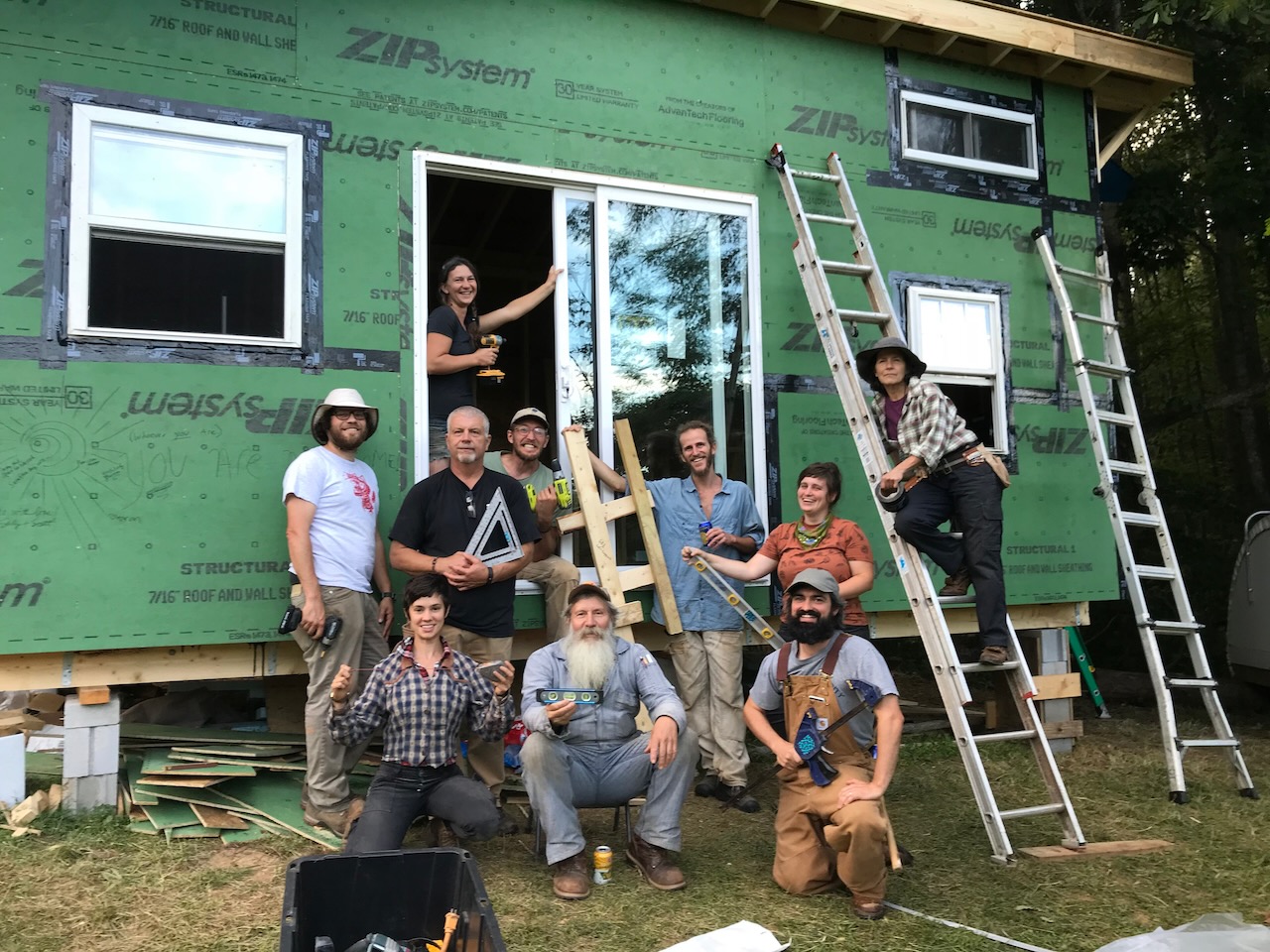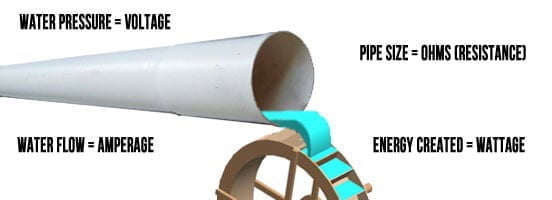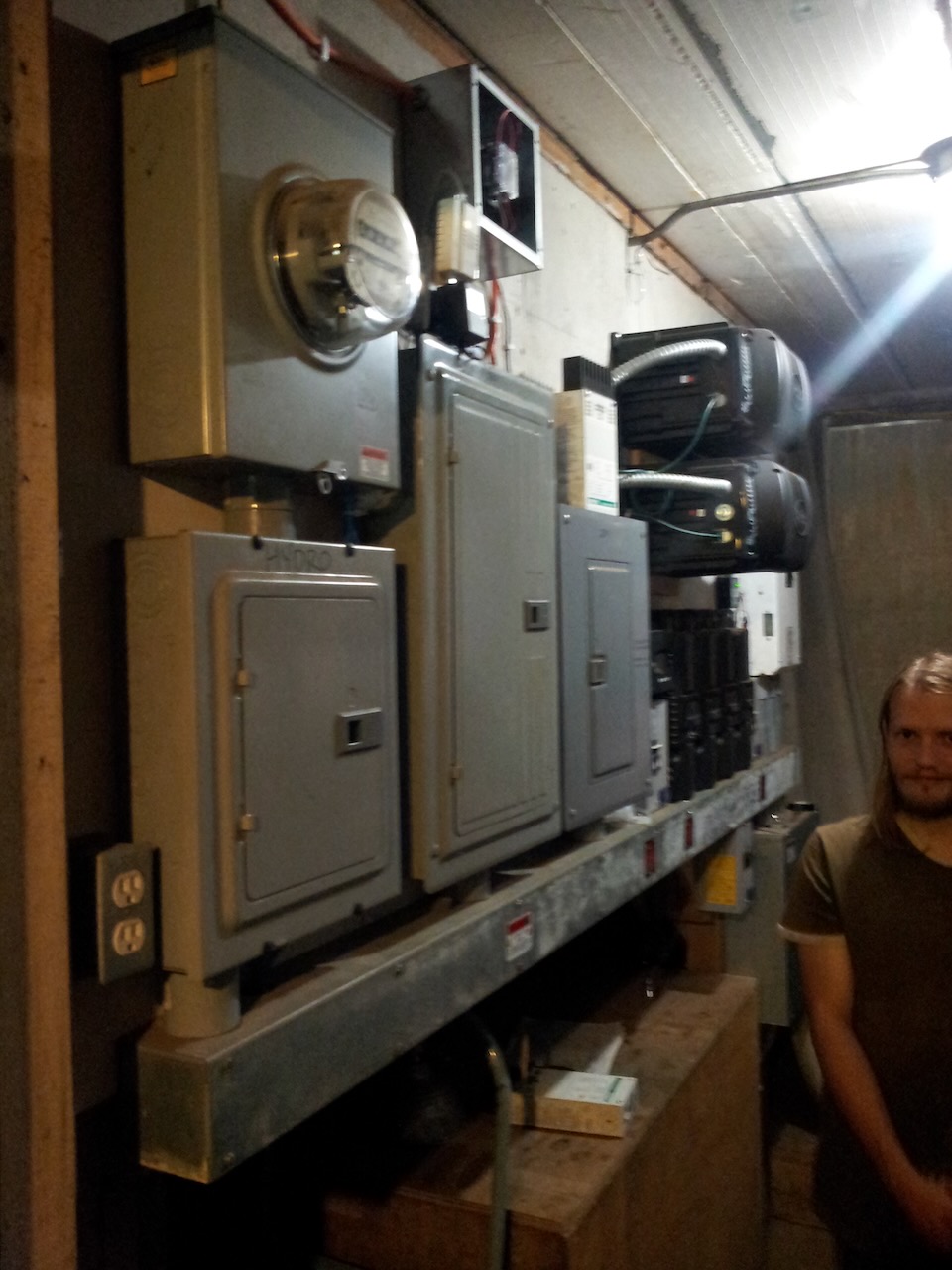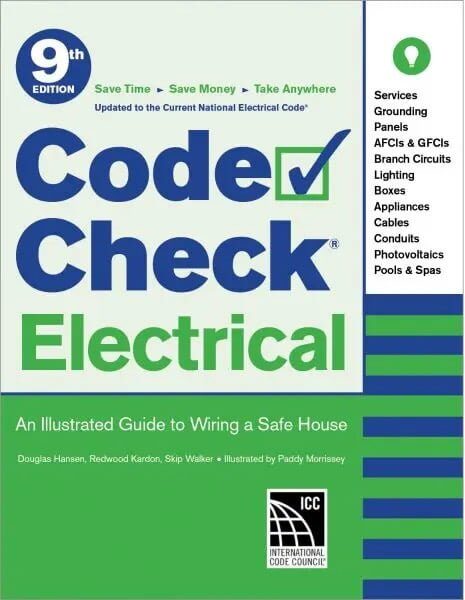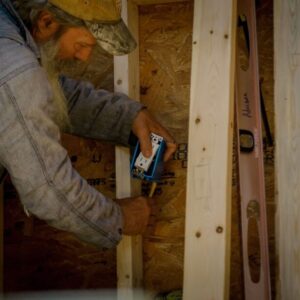A note on safety: This post, and all our offerings, are for educational purposes only. We recommend hiring a professional to help with your tiny house electrical system. The information here will give you a great foundation to help you feel confident in your conversations with an electrician. For more info enroll in our tiny house building class
Here is your essential guide to tiny house electrical.
We define technical terminology, discuss electricity needs for small spaces, and even go into solar systems for off-grid tiny houses.
Elements of a tiny house electrical system
The elements of a tiny house electrical system are the same as those for a larger house, there are just fewer of them. Following are some essential terms and parts of a tiny house electrical system. If you’re going off grid and opting for a solar system, these will remain the same, with the addition of solar panels, batteries, and an inverter.
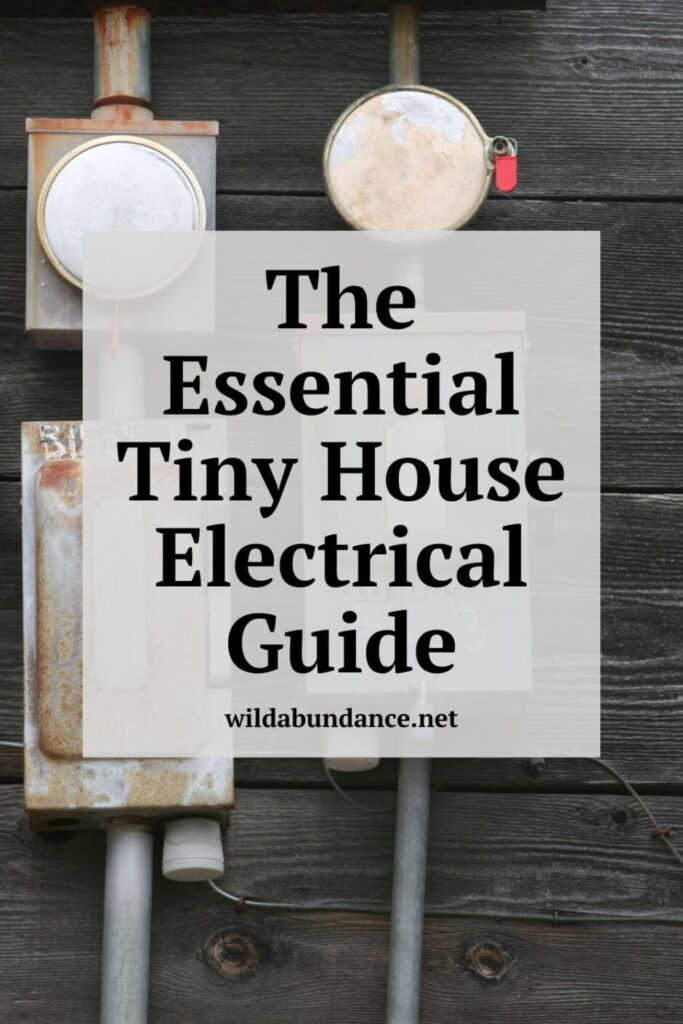

Grounding
Grounding is one of the most important things when you’re doing tiny house electrical. It’s there for safety, to get electricity back to the earth, where it wants to go. Without grounding, the electrical current may travel through your body to get back to the earth, giving you a shock. Indeed, the ground wire is going to be continuous throughout the whole tiny house electrical system, heading down into the ground.
Grounding also plays a role in system stability. It reduces the risk of equipment damage from voltage spikes caused by lightning or electrical surges. For off-grid systems, proper grounding of your inverter and battery bank is equally critical.
Volts
Volts are a common unit of measurement that you’re going to hear a lot when dealing with electricity. It’s a form of electrical force. In most homes, AC (alternating current) voltage is what you’ll be working with. Typically, 240 volts are what travel through the wires in a home. For a tiny house, you may be using 240 or 120. That’s because most outlets and gizmos run on half of 240, or 120 volts. However, high-energy appliances like ranges and dryers use 240 and require special breakers and wiring to handle the increased electrical force. What kinds of electrical appliances you’ll be using will help determine whether 240 or 120 volts is appropriate for your tiny house electrical system.
It’s also worth noting that many solar systems and battery setups operate on 12, 24, or 48 volts DC (direct current) before being converted to AC. Understanding the distinction between DC and AC systems is crucial for choosing the right inverter and ensuring compatibility with your appliances.
Amps
Amps are another unit of measurement in the world of electricity. They represent flow, or current. In order to understand electrical amps, it’s helpful to think of flowing water. In this case, the current is how much water is actually flowing through. Returning to our tiny house electrical system, amps represent how much electricity is flowing through.
One place you’ll encounter amps is in a breaker box, with the total amperage flowing into the box being broken up by different breakers. These allow different amounts of electricity to flow through them and out into circuits, via wires. It’s extremely important to use the right size wire for the amount of amps coming through; too many amps through an undersized wire can cause a fire. Breakers help to prevent this by limiting the number of amps that travel through each circuit they control.
When designing your tiny house electrical plans, estimating your maximum expected amperage will help you size your wire, breakers, and inlet properly.
In tiny homes, being mindful of watt usage is key to building an efficient system, especially when working with limited off-grid power sources. Keeping a log of the wattage ratings on your devices can help you prioritize your energy usage.
Watts, kilowatts, kilowatt hours
Watts and kilowatt hours are another important unit of measurement. In this case, they measure overall power consumption. To calculate watts, you simply multiply volts by amps. This number gives us an idea of how much power something is going to need. Finally, since we tend to use electricity over time, you can measure the number of watts per hour, or 1000 watts per hour, which is a kilowatt hour. Since most homes use many thousands of watts per hour, the kilowatt hour is a standard unit for measuring consumption of electricity; you’ll probably see it on your power bill.
Breaker box
The breaker box is where power comes in and gets spread throughout a tiny house electrical system. Individual breakers send a measured amount of flow of electrical current (amps) to each circuit in the house, via wires. If too many appliances are on at once, pulling more current through a circuit than it’s set up for, a breaker will flip. This cuts off power to that circuit and prevents a fire.
Some tiny homes use compact breaker panels that are specially designed for small spaces. You may also need a subpanel if you’re running both AC and DC systems.
Wire
There are many kinds of wire, and many sizes, or gauges, of each kind of wire. It’s extremely important to choose the correct wire for your application. Some wire is better suited for wet conditions, for bringing lots of current to an appliance like a dryer, or for easily bending to fit into small spaces.
Wire choice depends not only on amperage but also on distance. Longer wire runs cause voltage drop, which can affect performance—especially in DC systems. Consult voltage drop charts to make sure your wire size is adequate.
To learn more about the different parts of a tiny house electrical system, including how they fit together and how to hook up outlets, light fixtures, and more, enroll in our tiny house building class.
Tiny house electrical requirements
The electrical requirements of a tiny house depend largely on what kinds of electrical appliances you’ll be running. Since tiny houses are smaller than standard houses, you’ll naturally have lower electrical needs for lights, outlets, and heating/cooling. On the other hand, appliances with high electrical needs like refrigerators, stoves, toasters, hair dryers, clothes dryers, etc. will require a similar amount of electricity (except perhaps the fridge, if it’s a small fridge in a smaller space). The range of tiny house electrical requirements can be between 0-30 amps. See below for more details.
In terms of safety, the requirements for a tiny house electrical system are exactly the same as any other house. If you’re excited to dive into building codes for electrical, you can access the “bible of electrical,” also known as the National Electric Code (NEC) online for free! You will have to set up an account. This nearly 1000 page document will tell you all the ins and outs of electrical installations. It’s worth looking through, just to see how things are done, as you plan and design your tiny house electrical system.
Another great resource is the International Code Council Code Check Booklet: An Illustrated Guide to Wiring a Safe House. They really do a great job of consolidating all the rules down to what you’re mostly likely to run into. This is a great reference, even if you’re not going to do your own electrical system.
How many amps do I need for a tiny house?
If you’re planning to run most of the standard electric appliances, your tiny house electrical system will require around 30 amps. This is the most common setup for tiny houses and also for RVs. However, your electrical needs may be significantly lower than this, if you don’t opt for energy-intensive appliances like an electric refrigerator, electric range, or electric water heater.
Many of the participants in our tiny house building classes choose modest solar systems that simply provide electricity for lights and charging small devices. They may have access to a fridge in a community space or outdoor kitchen, use propane or wood for cooking and heating, and use hot water judiciously.
To get a sense of how many amps you might need for your tiny house, you can use this electricity calculator to get a feel for the maximum number of watts you’ll be using (remember, a kilowatt is 1000 watts). Then, divide that watts number by 240 or 120 volts, depending on the voltage your tiny house electrical system will use. The final number will be amps.
Here’s the formula: watts/volts=amps
And here’s an example of a tiny home electrical usage in watts:
- Ceiling fan: 25
- Lights x 5: 35
- Mini-fridge: 60
- Laptop: 60
- Phone: 15
- Electric kettle: 1000
- Space heater: 1500
- 5-gallon water heater: 1500
Total watts: 4,195
watts/volts = amps = 4,195/240 = 17.48 amps
How do you put electricity in a tiny house?
As with any home, it’s ideal to put electricity in a tiny house during construction. As the tiny house is being built, walls will be open and exposed, so wires can easily be run to outlets, appliances, and light fixtures. Including electrical in your tiny house design can be a helpful step in this process. Of course, you can always add to and change your tiny house electrical system later, but it will be more work than setting it up during construction.
For a tiny house on wheels, the most common ways to bring electricity in are through an RV plug, or a twist-lock 120 volt input. These both basically look like outlets on the outside of the tiny house. With them, you’ll plug in the whole house. After electricity comes in through these plugs, it will be distributed via a breaker box.
If you’re building a tiny house on a foundation, the mobile options are still great. In this case, you can also run a direct electrical line to the tiny house through an under or above ground conduit. Such a hard-wired option is what would be used for a shed, cabin, or other outbuilding.
Solar electric for a tiny house
Solar electric power is a great option for your tiny house electrical system, especially if you’re planning to bring your tiny house to remote places. Any solar electric system requires good solar exposure, so if your tiny house will be mostly in the shade, this isn’t going to work.
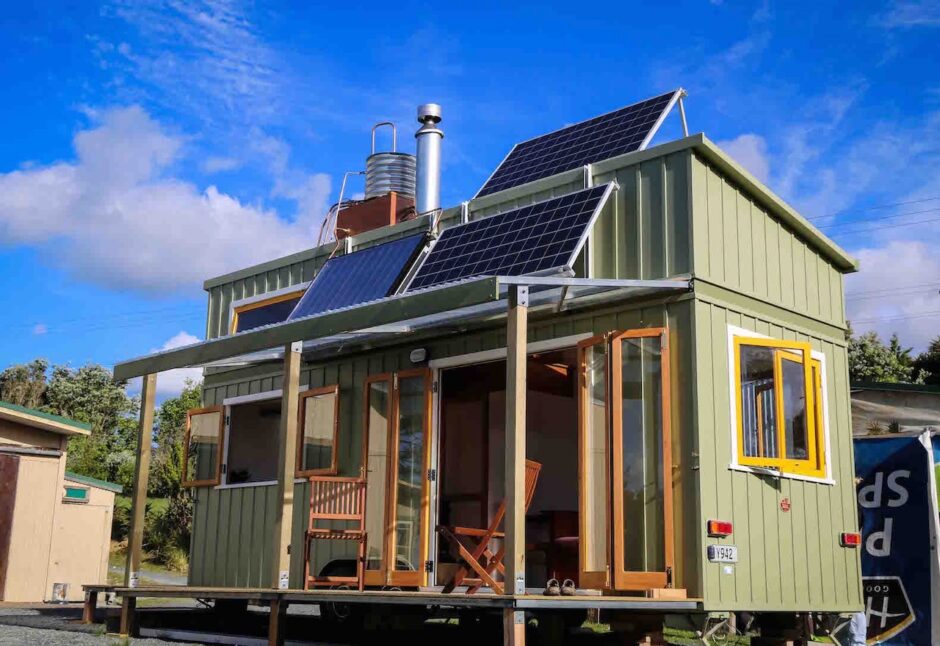

Image source: In Habitat
The basic elements of a solar electric system are: photovoltaic (PV, solar) panels, wiring, batteries, and an inverter. The panels collect solar energy and turn it into electricity; the batteries store that electricity; the inverter changes the electricity into the AC power that’s most common in homes; and the wiring moves the electricity around.
You can choose to mount our PV panels to the roof of your tiny house, or ground-mount them nearby. The batteries and inverter can either be housed within your tiny house, or in a utility space outside. For mobile units, creating a space for everything within the tiny house will be more convenient. For much more detailed information on solar power for tiny homes, enroll in our tiny house building class.
How Do Tiny Homes Get Electricity?
Tiny homes can get electricity in several ways, depending on whether they’re parked in a residential backyard, traveling the country, or nestled off-grid in nature. The most common method for grid-tied setups is plugging into a standard outlet or using an RV-style electrical hookup, which supplies AC power just like in a conventional home. This requires an inlet on the outside of the house and a properly installed breaker panel inside.
For more permanent installations—like tiny homes on foundations—you can run electrical conduit underground from the main house or utility pole. Off-grid options rely on solar panels and battery banks, with generators or wind turbines as backup. Each setup should be chosen based on your location, mobility, and energy needs.
How to Power a Tiny House Off Grid
To power a tiny house off grid, you’ll need a standalone electrical system that doesn’t rely on utility companies. Most often, this means installing a solar energy system that includes photovoltaic panels, a charge controller, deep-cycle batteries, and an inverter to convert DC to AC power. You can also incorporate a backup generator for days with limited sun.
Energy conservation becomes especially important when living off-grid. Prioritize LED lighting, energy-efficient appliances, and natural heating and cooling strategies. Cooking with propane and heating water with solar thermal or wood can also ease the load on your electrical system.
Keep in mind that state and local regulations may affect where and how you install off-grid systems, so it’s worth doing your research ahead of time or consulting with a professional.
How Many Solar Panels to Power a Tiny House?
The number of solar panels you’ll need depends on your daily energy usage and how much sunlight your site receives. On average, tiny homes use between 3 to 7 kilowatt-hours (kWh) per day. Assuming each solar panel produces about 300 watts and gets 4 hours of full sun per day, you’d need around 4 to 6 panels to meet basic needs like lighting, refrigeration, charging devices, and occasional use of appliances.
If you plan to run more energy-intensive systems like electric heat, air conditioning, or an induction stove, you’ll need more panels and a larger battery bank. A solar installer or detailed energy audit can help you size your system accurately. And remember, the orientation and angle of your panels, as well as geographic location, play a big role in efficiency.
When in doubt, it’s better to size your system a little bigger than you think you’ll need—it’s easier to expand solar capacity upfront than after the fact.
FAQs About Tiny House Electrical Systems
How does electricity work in a tiny house?
Electricity in a tiny house works much like it does in a traditional home. Power comes into the house via a plug-in (like an RV connection) or solar system, runs through a breaker panel, and is distributed through circuits to outlets, lights, and appliances. The setup can use either AC (alternating current) from the grid or DC (direct current) from solar panels, depending on the system design.
How much power does a tiny house use?
A typical tiny house uses between 3 and 7 kilowatt-hours (kWh) per day, depending on its appliances, lifestyle, and whether it’s grid-tied or off-grid. Lower energy homes rely on propane, wood, or solar thermal systems to reduce electrical consumption. The best way to estimate your usage is to tally the wattage of your devices and multiply by the number of hours you use them each day.
How to wire a tiny house for solar power?
Wiring a tiny house for solar involves installing photovoltaic panels, a charge controller, batteries, and an inverter. Wires carry power from the panels to the charge controller and batteries, then from the inverter to your home’s AC circuits. It’s important to use the correct wire gauge and safety components, and many people consult professionals or take hands-on classes to get it right.
Can you live in a tiny house with solar power alone?
Yes, many people live comfortably in tiny homes powered solely by solar energy. However, success depends on your energy usage, solar exposure, and battery storage capacity. Efficient appliances, energy conservation, and sunny conditions are key to making solar power your only source of electricity.
Do you need a permit for tiny house electrical work?
In many areas, yes. If your tiny home is on a foundation or permanently connected to the grid, you’ll likely need electrical permits and inspections. For off-grid or mobile setups, regulations vary widely. Always check with local building authorities to stay compliant and safe.
Ready to Start Wiring?
Understanding tiny house electrical systems is a key step in building a safe and sustainable small home. Whether you’re dreaming of going off-grid with solar or simply want to speak confidently with an electrician, getting hands-on experience can make all the difference.
Join us for our Tiny House Workshop, where you’ll learn not just about electrical systems, but every step of the building process—from design to framing to some of the finishing touches. It’s the perfect way to gain practical skills and turn your tiny house vision into reality.
